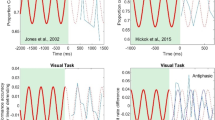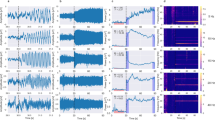Abstract
After the cessation of a sinusoidally modulated stimulus, the ERG response is found to continue, in the form of a damped oscillation (the time constant of the decay process being of the order of 1 sec) with the same frequency as the primary stimulus (3.7 Hz).
Access this chapter
Tax calculation will be finalised at checkout
Purchases are for personal use only
Preview
Unable to display preview. Download preview PDF.
Similar content being viewed by others
References
Asher, M.F. Off-effect giving rise to a sensation of blackness. J. Physiol. (Lond.) 137, 48 (1957).
Barlow, J.S., Morrel, L. & F. Morrel, Some observations on evoked response in relation to temporal conditioning to paired stimuli in man. Trans. int. Coll. Bratislava Acad. Sci., 11-14 sept. 1965 (1967).
Best, W. & X. Bohnen, Ueber den Off-Effekt in ERG des Menschen-Graef. Arch. Ophthal. 158, 565 (1957).
Biersdorf, W.R. & J.C. Armington, Responses of the human eye to sudden changes in the wavelength of stimulation. J. Opt. Soc. Am. 47, 208 (1957).
Bird, J.F. & G.H. Mombray, Analysis of transient visual sensations above the flicker fusion of frequency. Vision Res. 13, 673 (1973).
Boynton, R.M. Discrimination of homogeneous double Pulses. In: Handbook of Sensory Physiology, Jameson, D. & Hurvich, L.M. Eds., Vol. VII/4, Springer, Berlin (1972).
Brooks, B. & C. Huber, Evidence for the role of the transient neural “off-response” in perception of light decrement: a psychophysical test derived from neuronal data in the cat. Vision Res. 12, 1291 (1972).
Brown, J.L. Afterimages. In: Vision and Visual Perception, Graham C.H. Ed., Wiley, New York, p. 479 (1965).
Dodt, E. (1951) Cone ERG by flicker. Nature, 168, 738.
Harter, M.R. Visually evoked cortical responses to the on-and off-set of patterned light in humans. Vision Res. 11, 685 (1971).
Heck, J. Der off-Effekt im menschlichen ERG. Acta Physiol. Scand. 40, 113 (1957).
Ikeda, M. Temporal summation of positive and negative flashes in the visual system. J. Opt. Soc. Am. 55, 1527(1965).
Jayle, G.E., Boyer, R.L. & J.B. Saracco, L’Electroretinographie-Bases Physiolo-giques et Données Cliniques. Masson et Cie, Paris, Vol. I (1965).
John, E.R. Mechanisms of Memory. Ac Press, New York, pp. 354 and 418 (1967).
Le Grand, Y. Optique Physiologique, Ed. de la Rev. d’Opt. Paris, Vol. II (1948).
Levett, J. Non linear-linear transition in the frog intraretinal electroretinogram. Vision Res. 10, 1347(1970).
Levett, J. Linear-nonlinear-linear transition as a function of frequency in the retinal response to light. Vision Res. 12, 1301.
Liechtenstein, M. & R. Boucher, Minimum detectable dark interval between trains of perceptually fused flashes. J. Opt. Soc. Am. 50, 461 (1960).
Miller, N.D. Positive after-image following brief high intensity flashes. J. Opt. Soc. Am 56, 802 (1966).
Morrell, F., Barlow, J. & M.A. Brazier, Analysis of conditioned repetitive response by means of the average response computer. In: Recent Advances in Biological Psychiatry, Grune and Stratton Inc. U.S.A. (1960).
Nagata, M. & H. Takata, Off-responses of human eye and their significance in the photopic flicker ERG. Newsletter (ISCERG) 3, 4 (1962).
Pirenne, M.H. Retinal off-units and human visual acuity. J. Physiol. (Lond.) 137, 48 (1957).
Rashbass, C. The visibility of transient changes of luminance. J. Physiol. (Lond.) 210, 165 (1970).
Ronchi, L. Negative electrical off-responses of the human retina. Atti fond. G. Ron-chi, 15, 515 (1960).
Saunders, R.Mc D. Eigenvectors of the sensitivity to variations across the human central fovea-Vision Res. 13, 182 (1973).
Simonds, J.L. Application of characteristic vector analysis to photographic and optical response data. J. Opt. Soc. Am. 53, 968 (1963).
Spekreijse H. & J.H. Van Der Tweel, Flicker and noise. Suppl. Vision Res. N°l (Proc. Int. Iscerg Symp.), p. 275 (1966).
Sperling, G. Temporal and spatial visual masking. J. Opt. Soc. Am. 55, 541 (1965).
Troelstra, A. Non-linear system analysis in Electroretinography. Inst. for Perc. RVO-TNO, Soesterberg, The Netherlands (1964).
Troelstra, A. Harmonic distortion in the frog’s ERG and its possible relation to differences in latencies. Vision Res. 11, 403 (1971).
Troelstra, A. & N.M.J. Schweitzer A model for the scotopic electroretino-graphic system. In: Studies in Perception, Festschrift dedicated to M.A. Bouman, Inst. for Perc. RVO-TNO, Soesterberg, The Netherlands (1966).
Author information
Authors and Affiliations
Editor information
Rights and permissions
Copyright information
© 1976 Dr W. Junk b.v. Publishers
About this chapter
Cite this chapter
Ronchi, L., Molesini, G. (1976). Time Constant of the Decay Process of Both ERG and Ver at the Off-Set of Stimulation. In: Alfieri, R., Solé, P. (eds) XIIth I. S. C. E. R. G. Symposium. Documenta Ophthalmologica Proceedings Series, vol 10. Springer, Dordrecht. https://doi.org/10.1007/978-94-010-1575-2_14
Download citation
DOI: https://doi.org/10.1007/978-94-010-1575-2_14
Publisher Name: Springer, Dordrecht
Print ISBN: 978-90-6193-150-8
Online ISBN: 978-94-010-1575-2
eBook Packages: Springer Book Archive




